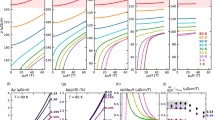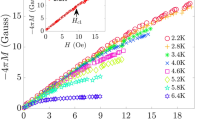Abstract
THE low temperatures produced by adiabatic demagnetization of potassium chrome alum have been used to cool various pure metals to about 0.1° K.; a copper rod was used for providing thermal contact between the metal and the salt1. The occurrence of any superconducting transition in the metal was indicated by a change in the magnetic susceptibility of the metal in an alternating field. Superconductivity was observed in osmium and ruthenium with transition temperatures of 0.71° K. and 0.47° K. respectively. A superconducting transition in ruthenium at 2.04° K. was previously reported by McLennan, Allen and Wilhelm2, but their specimen had a high residual resistance; and since no transition was observed by Meissner and Voigt3 down to 1.2° K. in a specimen with much lower residual resistance, it is probable that the high transition temperature was associated with impurity. The critical magnetic fields were found to satisfy the relation Hc = Ho (1 – (T/Tc)2); the values of Ho and Tc are compared in the accompanying table with recent measurements by Goodman and Mendoza4 on a number of other elements with low transition termperatures. The values for aluminium and zinc differ only slightly from those found by Daunt and Heer5.
This is a preview of subscription content, access via your institution
Access options
Subscribe to this journal
Receive 51 print issues and online access
$199.00 per year
only $3.90 per issue
Buy this article
- Purchase on SpringerLink
- Instant access to full article PDF
Prices may be subject to local taxes which are calculated during checkout
Similar content being viewed by others
References
Mendoza, E. B., Cérémonies Langevin–Perrin, Paris (1948).
McLennan, J. C., Allen, J. F., and Wilhelm, J. O., Trans. Roy. Soc. Canada, 23, (III), 283 (1929); 25, (III), 13 (1931).
Meissner, W., and Voigt, B., Ann. d. Phys., 7, 917 (1930).
Goodman, B. B., and Mendoza, E. B. (to be published).
Daunt, J. G., and Heer, C. V., Phys. Rev., 76, 1324 (1949).
Goodman, B. B., and Shoenberg, D., Nature, 165, 441 (1950).
Aschermann, G., and Justi, E., Phys. Z., 43, 207 (1942).
Justi, E., Z. Naturforsch., 4 a, 471 (1949).
Author information
Authors and Affiliations
Rights and permissions
About this article
Cite this article
GOODMAN, B. Two New Superconducting Elements. Nature 167, 111 (1951). https://doi.org/10.1038/167111a0
Issue date:
DOI: https://doi.org/10.1038/167111a0



